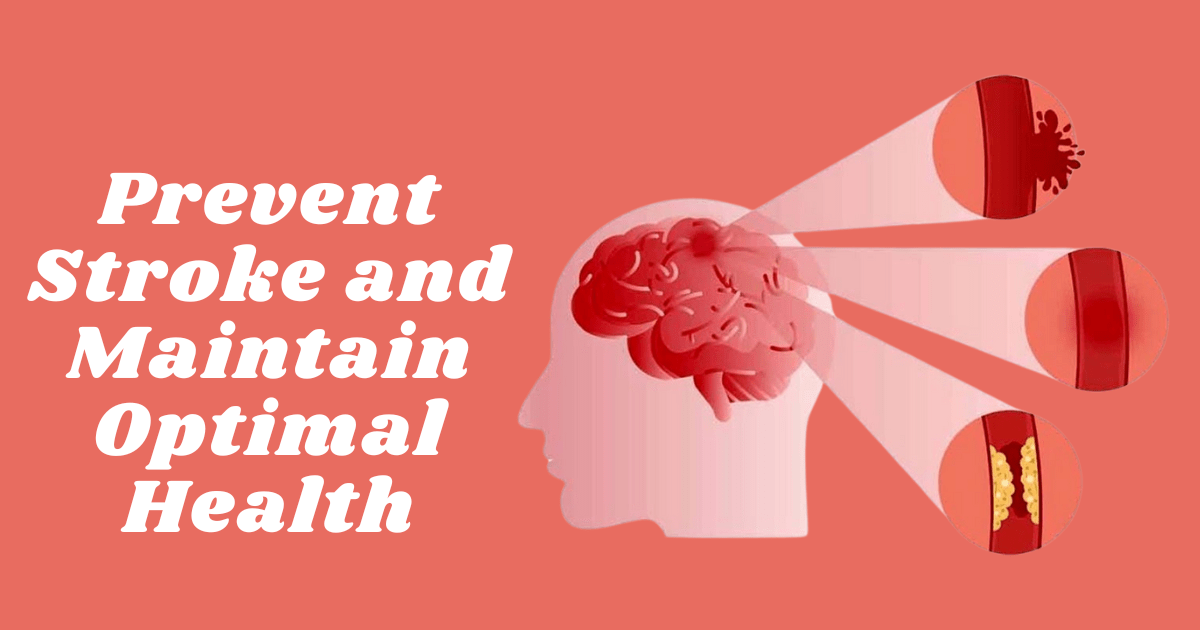When it comes to preventing strokes, knowledge is power. Understanding the causes, symptoms, and risk factors of stroke is crucial to taking proactive steps towards prevention. A stroke occurs when there is a disruption in the blood flow to the brain, either due to a blockage (ischemic stroke) or bleeding (hemorrhagic stroke). High blood pressure, smoking, diabetes, high cholesterol, and obesity are some of the common risk factors for stroke. Additionally, age, gender, family history, and certain medical conditions can also contribute to an increased risk. Being aware of these factors allows you to identify potential vulnerabilities and make informed decisions to reduce your risk of stroke.

1. The importance of early detection and prevention:
Early detection of stroke symptoms can significantly improve the chances of a positive outcome. The acronym FAST (face drooping, arm weakness, speech difficulty, and time to call emergency services) is a helpful tool to recognize common stroke symptoms. If you or someone around you experiences any of these symptoms, it is essential to seek immediate medical attention. Quick action can minimize the damage caused by a stroke and potentially save lives.
Prevention is always better than cure, and this holds true for stroke as well. By adopting a proactive approach to your health, you can significantly reduce the likelihood of experiencing a stroke. Regular health check-ups, monitoring your blood pressure, managing your cholesterol levels, and quitting smoking are some of the preventive measures you can take. Additionally, maintaining a healthy lifestyle through proper diet, regular exercise, and stress management plays a vital role in preventing stroke.
2. Healthy lifestyle choices to prevent stroke:
A healthy lifestyle is the cornerstone of stroke prevention. Making conscious choices in your daily life can have a significant impact on your overall health and reduce the risk of stroke. A balanced diet rich in fruits, vegetables, whole grains, lean proteins, and healthy fats can help maintain a healthy weight, control blood pressure, and manage cholesterol levels. Limiting the intake of processed foods, saturated fats, and sodium is also important in reducing the risk of stroke.
Getting regular exercise is another essential part of living a healthy lifestyle. Engaging in moderate-intensity exercise for at least 30 minutes a day, five days a week, can improve cardiovascular health, lower blood pressure, and control weight. Activities such as walking, swimming, cycling, and dancing are excellent choices for increasing physical activity levels. It’s important to find activities you enjoy to make exercise a sustainable part of your routine.
3. Diet and nutrition for stroke prevention:
The food we eat has a significant impact on our general health and wellbeing. When it comes to stroke prevention, a healthy and balanced diet is essential. Incorporating a variety of fruits and vegetables into your meals provides essential vitamins, minerals, and antioxidants that support cardiovascular health. Whole grains, such as brown rice, whole wheat bread, and oats, are excellent sources of fiber and can help lower cholesterol levels.
Lean proteins, such as fish, poultry, and legumes, are vital for muscle development and repair. Including sources of healthy fats, such as avocados, nuts, and olive oil, can help reduce inflammation and promote heart health. It’s important to limit the consumption of processed foods, sugary beverages, and foods high in saturated and trans fats, as they can contribute to weight gain and increase the risk of stroke.
4. Exercise and physical activity for stroke prevention:
Regular exercise and physical activity are not only beneficial for maintaining a healthy weight but also for preventing stroke. Engaging in aerobic exercises, such as brisk walking, jogging, cycling, or swimming, helps improve cardiovascular health and reduces the risk of high blood pressure and diabetes, both of which are risk factors for stroke. Strength training exercises, such as weightlifting or resistance training, can help build muscle strength and improve overall fitness.
Incorporating physical activity into your daily routine is key to reaping the benefits. Finding activities you enjoy and making them a part of your everyday life can help make exercise a sustainable habit. Walking or biking to work, taking the stairs instead of the elevator, or joining a fitness class are all simple ways to increase physical activity levels. To prevent injury, always start out slowly and increase the duration and intensity of your workouts gradually.
5. Managing stress and mental health for stroke prevention:
Chronic stress and poor mental health can have a significant impact on your overall well-being and increase the risk of stroke. Finding healthy ways to manage stress and promote mental well-being is essential for stroke prevention. Engaging in activities that help you relax and unwind, such as yoga, meditation, deep breathing exercises, or spending time in nature, can help reduce stress levels.
Maintaining strong social connections and seeking support from loved ones can also contribute to better mental health. If you’re struggling with stress or mental health issues, it’s important to reach out to a healthcare professional who can provide guidance and support. Taking care of your emotional well-being is just as important as taking care of your physical health when it comes to stroke prevention.
6. Stroke prevention strategies for different age groups:
Stroke can affect individuals of all ages, but certain age groups may have specific risk factors to consider. Understanding these risk factors and implementing appropriate prevention strategies can help reduce the likelihood of stroke. For younger individuals, focusing on lifestyle factors such as maintaining a healthy weight, regular exercise, and avoiding smoking is crucial.
As individuals age, the risk of stroke tends to increase. Managing chronic medical conditions, such as high blood pressure, diabetes, and high cholesterol, becomes even more important. Regular check-ups and screenings can help monitor these conditions and ensure they are well-managed. Additionally, making adaptations to lifestyle choices, such as reducing alcohol consumption and maintaining a healthy diet, can further reduce the risk of stroke.
7. Medical interventions and treatments for stroke prevention:
In addition to lifestyle changes, medical interventions and treatments can play a significant role in stroke prevention. Depending on individual risk factors and medical history, healthcare professionals may recommend certain medications to manage conditions such as hypertension, high cholesterol, or diabetes. These medications help control these conditions, reducing the risk of stroke.
In some cases, surgical interventions may be necessary to address specific risk factors. For example, individuals with certain heart conditions may require procedures such as aortic valve replacement or carotid endarterectomy to reduce the risk of stroke. It is important to consult with a healthcare professional to determine the most appropriate medical interventions for your specific situation.
8. Support and resources for stroke prevention:
Taking control of your health and preventing stroke can be an empowering journey. Thankfully, there are numerous resources and support networks available to assist you. Local healthcare providers, community organizations, and online platforms can provide valuable information, educational materials, and support groups focused on stroke prevention. Staying connected with these resources can help you stay motivated, informed, and supported throughout your preventive journey.
Additionally, reaching out to healthcare professionals who specialize in stroke prevention can provide personalized guidance and support. They can assess your individual risk factors, provide tailored recommendations, and help you navigate any medical interventions or treatments that may be necessary. Remember, you are not alone in your quest to prevent stroke, and there are many people ready to support you along the way.
Conclusion: Taking control of your health and preventing stroke
Stroke is a serious and potentially life-threatening condition, but it is not inevitable. By understanding the causes, symptoms, and risk factors of stroke, you can take proactive steps towards prevention. Adopting a healthy lifestyle, including a balanced diet, regular exercise, stress management, and seeking support for mental health, can significantly reduce the risk of stroke. Depending on individual risk factors, medical interventions and treatments may also be necessary to further enhance stroke prevention efforts. By taking control of your health and implementing effective strategies, you can stay ahead of the game and maintain optimal health for years to come.
CTA: Take charge of your health today! Start by scheduling a check-up with your healthcare provider and discussing your risk factors for stroke. Make small but meaningful changes to your lifestyle, such as incorporating more fruits and vegetables into your diet, engaging in regular physical activity, and finding healthy ways to manage stress. Remember, prevention is key, and by prioritizing your health, you can significantly reduce the risk of stroke and maintain optimal well-being.

2 comments
Thanks I have just been looking for information about this subject for a long time and yours is the best Ive discovered till now However what in regards to the bottom line Are you certain in regards to the supply
Very well presented. Every quote was awesome and thanks for sharing the content. Keep sharing and keep motivating others.